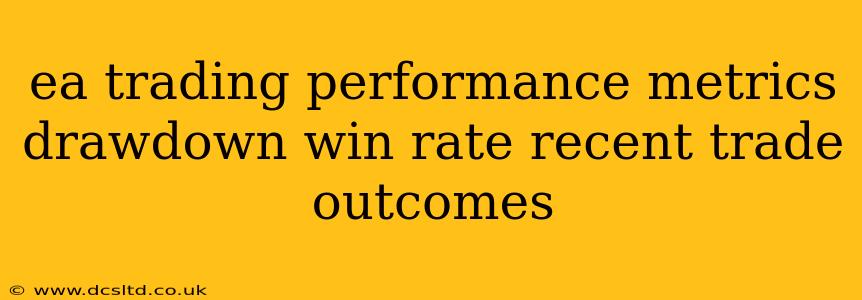For those venturing into the world of automated trading, understanding key performance metrics is crucial. This guide delves into the essential metrics for evaluating the effectiveness of an Expert Advisor (EA), focusing on drawdown, win rate, and recent trade outcomes. Mastering these metrics will significantly improve your ability to select, optimize, and manage your EAs for optimal profitability and risk mitigation.
What is Drawdown in EA Trading?
Drawdown represents the peak-to-trough decline during a specific period. In simpler terms, it measures the maximum percentage drop from a peak balance to a subsequent trough in your trading account. A high drawdown indicates significant risk, potentially leading to substantial losses. Understanding drawdown is vital because it highlights the resilience of your EA against market volatility. A low drawdown suggests a more stable and less risky trading strategy. Consider it a crucial indicator of your EA's ability to withstand adverse market conditions. For example, a 10% drawdown means your account balance has decreased by 10% from its highest point during that period.
How to Interpret Drawdown?
The significance of drawdown depends heavily on your risk tolerance. While a small drawdown (e.g., under 5%) might be acceptable for some, others might prefer even lower drawdowns to minimize risk. Always compare the drawdown against the overall profit to determine the risk-reward ratio. A high profit with a low drawdown is an ideal scenario, while a high profit coupled with a high drawdown warrants caution. Furthermore, it's useful to analyze the frequency and duration of drawdowns. Frequent and prolonged drawdowns are a red flag, suggesting potential flaws in the EA's strategy.
What is Win Rate in EA Trading?
Win rate refers to the percentage of trades that result in profits. A high win rate suggests a strategy with a strong predictive capability. However, it's crucial to remember that win rate alone isn't a definitive indicator of profitability. While a high win rate is desirable, the size of winning trades (relative to losing trades) is equally important. A low win rate combined with substantial gains on winning trades can still yield significant profitability. Conversely, a high win rate with small profits might lead to overall losses due to cumulative transaction costs and slippage.
Win Rate vs. Profit Factor: A Crucial Distinction
Many traders mistakenly rely solely on win rate. A more comprehensive approach involves considering the profit factor, which is the ratio of total profits to total losses. This metric offers a more accurate representation of the EA's profitability. A profit factor greater than 1 indicates profitable trading, while a value less than 1 points towards losses. For instance, an EA with a 40% win rate but a profit factor of 2 is clearly more profitable than one with a 60% win rate but a profit factor of 0.8.
Recent Trade Outcomes: The Importance of Monitoring
Analyzing recent trade outcomes provides valuable insights into the EA's current performance and potential adjustments. Reviewing the individual trades allows you to identify any patterns, weaknesses, or anomalies. Were there clusters of losing trades? Were there any surprising winners or losers? Did the EA adapt well to recent market shifts? Careful monitoring of recent trade performance helps you make informed decisions about your trading strategy, including adjustments to parameters or even complete EA replacement if necessary.
Utilizing Backtesting and Forward Testing
While past performance isn't necessarily indicative of future results, backtesting and forward testing are invaluable for understanding the historical and current performance of your EA. Backtesting assesses the performance of your EA on historical data, providing an initial evaluation. However, forward testing – using real-time market data – offers a more realistic picture of the EA’s ability to adapt to dynamic market conditions.
Frequently Asked Questions (FAQ)
What constitutes a "good" drawdown?
There's no universally accepted definition of a "good" drawdown. It heavily depends on your risk tolerance and the overall profitability of the EA. A drawdown of less than 10% is generally considered acceptable for many traders, but some may prefer even lower levels.
How can I improve my EA's win rate?
Improving the win rate often involves refining the entry and exit rules within your EA’s trading strategy. This might involve adjusting parameters, adding filters to improve trade selection, or implementing more sophisticated risk management techniques.
Is a high win rate always desirable?
No. While a high win rate is generally positive, it's more crucial to consider the profit factor and the overall profitability of the strategy. A high win rate with small profits might still lead to net losses.
By diligently monitoring these key performance indicators, you can gain a clear understanding of your EA’s effectiveness, manage risk effectively, and improve your overall trading performance. Remember that consistent monitoring and adaptation are crucial for long-term success in automated trading.
